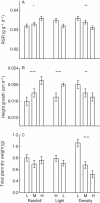Optimal allocation of resources in response to shading and neighbours in the heteroblastic species, Acacia implexa
- PMID: 21135029
- PMCID: PMC3025730
- DOI: 10.1093/aob/mcq228
Optimal allocation of resources in response to shading and neighbours in the heteroblastic species, Acacia implexa
Abstract
Background and aims: Heteroblasty is an encompassing term referring to ontogenetic changes in the plant shoot. A shaded environment is known to affect the process of heteroblastic development; however, it is not known whether crowded or high density growing conditions can also alter heteroblasty. Compound leaves of the shade-intolerant Acacia implexa allocate less biomass per unit photosynthetic area than transitional leaves or phyllodes and it is hypothesized that this trait will convey an advantage in a crowded environment. Compound leaves also have larger photosynthetic capture area - a trait known to be advantageous in shade. This studied tested the hypothesis that more compound leaves will be developed under shade and crowded environments. Furthermore, this species should undergo optimal allocation of biomass to shoots and roots given shaded and crowded environments.
Methods: A full factorial design of irradiance (high and low) and density levels (high, medium and low) on three populations sourced from varying rainfall regions (high, medium and low) was established under controlled glasshouse conditions. Traits measured include the number of nodes expressing a compound leaf, biomass allocation to shoots and roots, and growth traits. Key Results A higher number of nodes expressed a compound leaf under low irradiance and in high density treatments; however, there were no significant interactions across treatments. Phenotypes strongly associated with the shade avoidance syndrome were developed under low irradiance; however, this was not observed under high density. There was no significant difference in relative growth rates across light treatments, but growth was significantly slower in a crowded environment. Conclusions Heteroblastic development in Acacia can be altered by shade and crowded environments. In this experiment, light was clearly the most limiting factor to growth in a shaded environment; however, in a crowded environment there were additional limiting resources to growth.
Figures






References
-
- Atkin OK, Schortemeyer M, McFarlane N, Evans JR. Variation in the components of relative growth rate in ten Acacia species from contrasting environments. Plant, Cell and Environment. 1998;21:1007–1017.
-
- Atkinson IAE, Greenwood RM. Relationships between moas and plants. New Zealand Journal of Ecology. 1989;12S:67–98.
-
- Ashton DH. Studies on the autecology of Eucalyptus regnans, F.v.M. 1956 PhD Thesis, University of Melbourne.
-
- Ashton DH, Turner JS. Studies on the light compensation point of Eucalyptus regnans F. Muell. Australian Journal of Botany. 1979;27:589–607.
-
- Ballaré CL. Keeping up with the neighbours: phytochrome sensing and other signalling mechanisms. Trends in Plant Sciences. 1999;4:97–102. - PubMed

